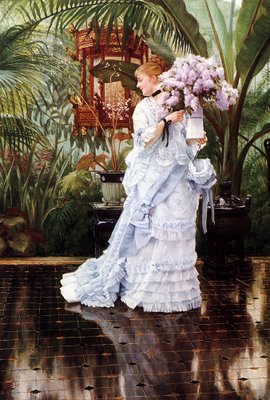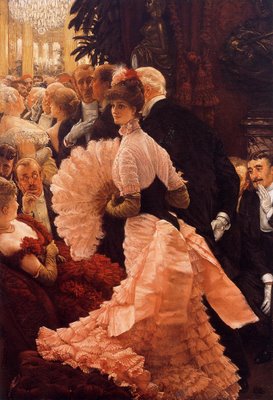 James Jacques Joseph Tissot (1836-1902) was a French Neoclassical painter. A native of Nantes, he studied at the Ecole des Beaux Arts and lived in Paris until the disastrous Franco-Prussian War and bloody Paris Commune. In 1871, he fled to London in response.
James Jacques Joseph Tissot (1836-1902) was a French Neoclassical painter. A native of Nantes, he studied at the Ecole des Beaux Arts and lived in Paris until the disastrous Franco-Prussian War and bloody Paris Commune. In 1871, he fled to London in response.Although Tissot was initially an Impressionist, he learned that he could make more money by creating Academic-style paintings of fashionable Victorian society. His decision created a permanent rift between himself and his Impressionist colleagues.
Tissot later married a disgraced adulterous divorcee, causing him to withdraw from London's social scene. When his wife died in 1882, he moved back to Paris and devoted the rest of his life to painting religious scenes.
 Tissot's dominant motif was the cultured bourgeoise of London. A Bunch of Lilacs (1875) is representative. One of the qualities that I enjoy about Tissot is his remarkable capacity to vividly express emotion on canvas, as demonstrated in this work's palpable joy.
Tissot's dominant motif was the cultured bourgeoise of London. A Bunch of Lilacs (1875) is representative. One of the qualities that I enjoy about Tissot is his remarkable capacity to vividly express emotion on canvas, as demonstrated in this work's palpable joy. The Ball on Shipboard (1874). Tissot was a master of detail. If you look carefully, you will see that each person in this scene has an agenda, from the bored woman at the left, the old man at the center calculating his chances with her, the gossips to his right, or the fatigued beauty ascending the stairs.
The Ball on Shipboard (1874). Tissot was a master of detail. If you look carefully, you will see that each person in this scene has an agenda, from the bored woman at the left, the old man at the center calculating his chances with her, the gossips to his right, or the fatigued beauty ascending the stairs. Many Tissot paintings were subtle satires of high society, such as A Woman of Ambition (1883). This woman has attached herself to an elderly gentleman and purchased the frilliest dress she could find in the hope of rising in Britian's class structure. Those around her are more amused than impressed.
Many Tissot paintings were subtle satires of high society, such as A Woman of Ambition (1883). This woman has attached herself to an elderly gentleman and purchased the frilliest dress she could find in the hope of rising in Britian's class structure. Those around her are more amused than impressed.

2 comments:
The Bunch of Lilacs is excellent. I particularly like the floor and how he handles the reflections.
I agree. That reflection is excellently executed.
Post a Comment